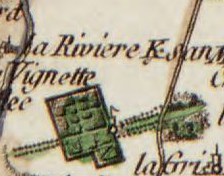|
K with diagonal stroke K with diagonal stroke (Ꝃ, ꝃ) is a letter of the Latin alphabet, derived from K with the addition of a diagonal bar through the leg. UsageThis letter is used in medieval texts as an abbreviation for kalendas, calends, as well as for karta and kartam, a document or writ.[1][2] The same function could also be performed by "K with stroke" (Ꝁ, ꝁ), or "K with stroke and diagonal stroke" (Ꝅ, ꝅ).[1] In the Breton language, this letter is used, mainly from the fifteenth to the twentieth century, to abbreviate Ker, a prefix used in place names, similar to the Welsh caer.[3]
Computer encodingsCapital and small K with diagonal stroke is encoded in Unicode as of version 5.1, at codepoints U+A742 and U+A743.[4][5] It may be transliterated as ⟨K'⟩ or ⟨K/⟩ as in the name of Emeline K/Bidi (French pronunciation: [kɛʁbidi]), a French Réunion politician with a Breton surname.[6] References
Bibliography
Information related to K with diagonal stroke |



